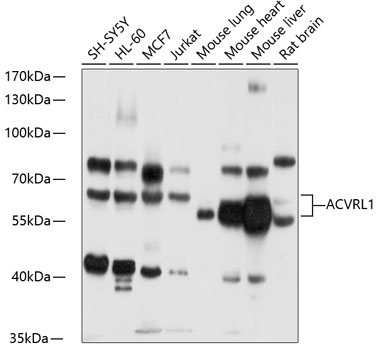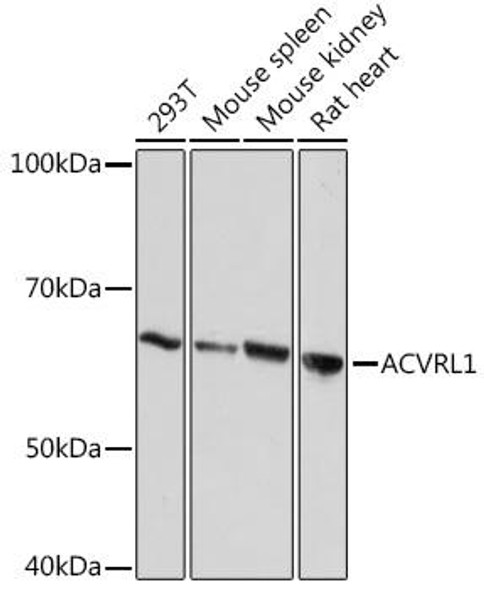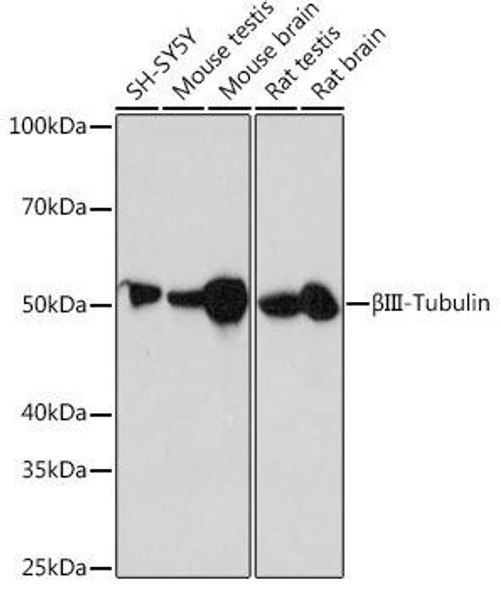Cardiovascular Antibodies
Anti-ACVRL1 Antibody (CAB1791)
- SKU:
- CAB1791
- Product Type:
- Antibody
- Reactivity:
- Human
- Reactivity:
- Mouse
- Reactivity:
- Rat
- Host Species:
- Rabbit
- Isotype:
- IgG
- Antibody Type:
- Polyclonal Antibody
- Research Area:
- Cardiovascular
Description
| Antibody Name: | Anti-ACVRL1 Antibody |
| Antibody SKU: | CAB1791 |
| Antibody Size: | 20uL, 50uL, 100uL |
| Application: | WB |
| Reactivity: | Human, Mouse, Rat |
| Host Species: | Rabbit |
| Immunogen: | Recombinant protein of human ACVRL1 |
| Application: | WB |
| Recommended Dilution: | WB 1:500 - 1:2000 |
| Reactivity: | Human, Mouse, Rat |
| Positive Samples: | SH-SY5Y, HL-60, MCF7, Jurkat, Mouse lung, Mouse heart, Mouse liver, Rat brain |
| Immunogen: | Recombinant protein of human ACVRL1 |
| Purification Method: | Affinity purification |
| Storage Buffer: | Store at -20'C. Avoid freeze / thaw cycles. Buffer: PBS with 0.02% sodium azide, 50% glycerol, pH7.3. |
| Isotype: | IgG |
| Sequence: | Email for sequence |
| Gene ID: | 94 |
| Uniprot: | P37023 |
| Cellular Location: | Membrane, Single-pass type I membrane protein |
| Calculated MW: | 56kDa |
| Observed MW: | 65kDa |
| Synonyms: | ACVRL1, ACVRLK1, ALK-1, ALK1, HHT, HHT2, ORW2, SKR3, TSR-I |
| Background: | This gene encodes a type I cell-surface receptor for the TGF-beta superfamily of ligands. It shares with other type I receptors a high degree of similarity in serine-threonine kinase subdomains, a glycine- and serine-rich region (called the GS domain) preceding the kinase domain, and a short C-terminal tail. The encoded protein, sometimes termed ALK1, shares similar domain structures with other closely related ALK or activin receptor-like kinase proteins that form a subfamily of receptor serine/threonine kinases. Mutations in this gene are associated with hemorrhagic telangiectasia type 2, also known as Rendu-Osler-Weber syndrome 2. |
| UniProt Protein Function: | ALK1: a kinase of the STKR family. A type I cell-surface receptor for the TGF-beta superfamily of ligands including Activin A. Highly expressed in human placenta and lung. Deficiency causes hemorrhagic telangiectasia type 2 also known as Rendu-Osler-Weber syndrome 2. |
| UniProt Protein Details: | Protein type:EC 2.7.11.30; Kinase, protein; Membrane protein, integral; Protein kinase, Ser/Thr (receptor); Protein kinase, TKL; STKR family; TKL group; Type1 subfamily Chromosomal Location of Human Ortholog: 12q13.13 Cellular Component: cell surface; integral to plasma membrane; plasma membrane Molecular Function:activin binding; activin receptor activity, type I; ATP binding; protein binding; protein kinase binding; protein serine/threonine kinase activity; SMAD binding; transforming growth factor beta binding; transforming growth factor beta receptor activity; transforming growth factor beta receptor activity, type I Biological Process: angiogenesis; blood circulation; blood vessel endothelial cell proliferation during sprouting angiogenesis; blood vessel maturation; blood vessel remodeling; BMP signaling pathway; lymphangiogenesis; negative regulation of blood vessel endothelial cell migration; negative regulation of cell adhesion; negative regulation of cell growth; negative regulation of cell migration; negative regulation of cell proliferation; negative regulation of focal adhesion formation; positive regulation of BMP signaling pathway; positive regulation of chondrocyte differentiation; positive regulation of transcription from RNA polymerase II promoter; positive regulation of transcription, DNA-dependent; protein amino acid phosphorylation; regulation of blood pressure; regulation of blood vessel endothelial cell migration; regulation of DNA replication; regulation of endothelial cell proliferation; regulation of transcription, DNA-dependent; signal transduction; transforming growth factor beta receptor signaling pathway; wound healing, spreading of epidermal cells Disease: Telangiectasia, Hereditary Hemorrhagic, Type 2 |
| NCBI Summary: | This gene encodes a type I cell-surface receptor for the TGF-beta superfamily of ligands. It shares with other type I receptors a high degree of similarity in serine-threonine kinase subdomains, a glycine- and serine-rich region (called the GS domain) preceding the kinase domain, and a short C-terminal tail. The encoded protein, sometimes termed ALK1, shares similar domain structures with other closely related ALK or activin receptor-like kinase proteins that form a subfamily of receptor serine/threonine kinases. Mutations in this gene are associated with hemorrhagic telangiectasia type 2, also known as Rendu-Osler-Weber syndrome 2. [provided by RefSeq, Jul 2008] |
| UniProt Code: | P37023 |
| NCBI GenInfo Identifier: | 3915750 |
| NCBI Gene ID: | 94 |
| NCBI Accession: | P37023.2 |
| UniProt Secondary Accession: | P37023,A6NGA8, |
| UniProt Related Accession: | P37023 |
| Molecular Weight: | 56,124 Da |
| NCBI Full Name: | Serine/threonine-protein kinase receptor R3 |
| NCBI Synonym Full Names: | activin A receptor like type 1 |
| NCBI Official Symbol: | ACVRL1 |
| NCBI Official Synonym Symbols: | HHT; ALK1; HHT2; ORW2; SKR3; ALK-1; TSR-I; ACVRLK1 |
| NCBI Protein Information: | serine/threonine-protein kinase receptor R3 |
| UniProt Protein Name: | Serine/threonine-protein kinase receptor R3 |
| UniProt Synonym Protein Names: | Activin receptor-like kinase 1; ALK-1; TGF-B superfamily receptor type I; TSR-I |
| Protein Family: | Serine/threonine-protein kinase haspin |
| UniProt Gene Name: | ACVRL1 |







